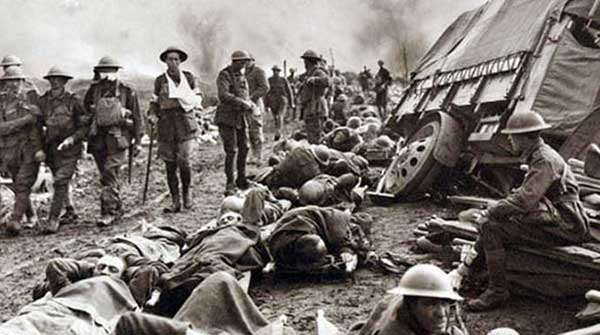 Antony Beevor is a prolific English military historian, most famous for the bestseller Stalingrad. First published in the late 1990s, the book’s narrative covers the period between the June 1941 German invasion of the Soviet Union and the conclusion of the Battle of Stalingrad in February 1943. That battle is often described as the Second World War’s deadliest and the Soviet victory marked a critical turning point.
Antony Beevor is a prolific English military historian, most famous for the bestseller Stalingrad. First published in the late 1990s, the book’s narrative covers the period between the June 1941 German invasion of the Soviet Union and the conclusion of the Battle of Stalingrad in February 1943. That battle is often described as the Second World War’s deadliest and the Soviet victory marked a critical turning point.
Beevor’s latest effort sees him back in the same general geography and cultural milieu. It’s called Russia: Revolution and Civil War, 1917-1921.
An early review suggests a harrowing read. If you’re surprised by the current carnage in Ukraine, you’ll discover that it has ample ancestry.
The March 1918 Brest-Litovsk Treaty may have ended Russian participation in the First World War, but it didn’t signal the onset of peace. Far from it. And because the collapsing Russian Empire was geographically vast, the book’s action sweeps across a wide terrain, including Siberia, Crimea, Poland and Ukraine.
The ensuing civil war was fought between the Reds (Bolshevik communists) and the Whites (a varied array of anti-communists). In addition to claiming an estimated 12 million lives, it was a war characterized by egregious brutality.
As recounted in Sara Wheeler’s Spectator review, some of the incidents were particularly grotesque: “An old colonel is roasted alive in the furnace of a locomotive. Victims were bound with barbed wire and pushed through ice holes or were skinned alive. In Kyiv, the Reds attached a short length of pipe to a prisoner’s stomach, fastened it securely and inserted a rat, setting fire to the other end so the rodent had to eat its way out.”
Beevor’s personal summary is succinct: “All too often the Whites represented the worst examples of humanity. For ruthless inhumanity, however, the Bolsheviks were unbeatable.”
Readers of Timothy Snyder’s Bloodlands (2010) will find much of this familiar. Snyder’s time frame is different but the location and horror are substantially the same.
Snyder focuses on the activities and interactions of the Soviet Union and Nazi Germany between 1933 and 1945. His story paints a devastating picture of state-sponsored mass murder in what he dubs “the bloodlands.” Situated in central and eastern Europe, Snyder’s killing fields embrace Poland, Belarus, Ukraine, the Baltics and western Russia.
There, Adolf Hitler and Josef Stalin pursued their respective “transformative utopias.” In the process, they orchestrated and inspired the slaughter of millions. Snyder puts the number of bloodlands corpses at around 14 million; and that’s without counting battlefield deaths. The means of dispatch were varied – gassing, mass shootings, planned starvation and so on.
It would, however, be a mistake to believe that war’s unsavouriness is anything less than ubiquitous. By its very nature, the ferocity of sustained combat is conducive to behaviours that would be deemed shocking in normal life.
And although the scale of evil can vary dramatically, the good guys aren’t necessarily immune from doing things we’d rather not talk about.
For instance, historian Michael Burleigh has this to say about Normandy: “Canadian troops routinely killed German captives after D-Day, partly because there had been instances of atrocities, but mainly because they were viewed as an encumbrance to advancing troops.”
And a man with substantial direct Second World War experience – British Army Capt. John Tonkin – didn’t have any illusions: “I have always felt that the Geneva Convention is a dangerous piece of stupidity, because it leads people to believe that war can be civilized. It can’t.”
One obvious response is to declare that war is evil and should be avoided at all costs. But is pacifism always a practical – or even morally appropriate – option?
And if not, how realistic is it to throw soldiers into the trauma of extended conflict and then expect them to always behave with the punctiliousness of human-rights lawyers?
Burleigh’s bottom line is presented in the preface to his book Moral Combat (2010): “While I do not think any war has ever been good, the Second World War, which killed 55 million people, was a necessary war against at least one regime which, uniquely, modernized barbarism into an industrial process, and another that visited cruelty and savagery on the many peoples of East Asia, from the Chinese to indigenous tribes on remote Pacific islands.”
One more thing: Be grateful that you don’t live in the bloodlands.
Pat Murphy casts a history buff’s eye at the goings-on in our world. Never cynical – well, perhaps a little bit. For interview requests, click here.
The opinions expressed by our columnists and contributors are theirs alone and do not inherently or expressly reflect the views of our publication.
© Troy Media
Troy Media is an editorial content provider to media outlets and its own hosted community news outlets across Canada.


